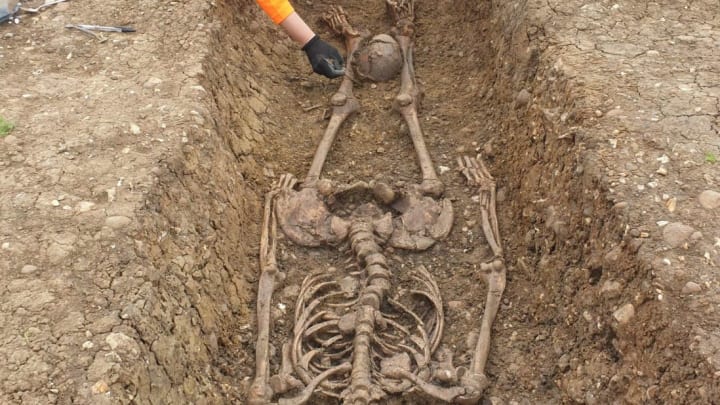Currently underway in England is a construction project for HS2 (“High Speed 2”), an expansive, high-speed, high-capacity railway system that, according to its website, “will form the backbone of Britain’s transport network.” But before HS2 moves the country into the future, they want to ensure they didn’t inadvertently erase the past, so they assembled teams of archaeologists to excavate along planned railway routes.

Their latest find is the vestiges of an ancient Roman town in Fleet Marston, a tiny village slightly under an hour’s drive northeast of Oxford. Apparently, it used to be quite a happening place: There seems to have been plenty of commerce, as evidenced by the more than 1200 gold coins and several lead weights found at the site. Certain sections of the road were especially wide, which, according to an HS2 news release, could mean that a market was held there, as the extra space would have provided extra room for carts and stalls.

Other artifacts—including spoons, pottery, and even a lead die—suggest that the town wasn’t just a commercial epicenter; people lived there, too. This is also supported by the discovery of a cemetery in which researchers uncovered around 425 graves. Though some of the deceased had been cremated, most bodies were buried intact. And for about 10 percent of all the burials, the skulls were detached from the rest of their skeletons. Some had been placed next to the person’s feet or between their legs.

As Live Science reports, the circumstances of these beheadings are something of a mystery. Britain boasts a surprisingly large proportion of decapitation burials compared to other parts of the Roman Empire—two unearthed in Suffolk circa 2019 were children—and some experts believe cutting the heads off corpses was a funerary rite. That said, beheading was a fairly common form of execution during the era, and there’s a good chance at least some of Fleet Marston’s headless former occupants had been punished for crimes. In either case, there may be a spiritual reason for positioning the heads so far from their necks: to keep the dead from coming back to haunt their living counterparts.

“No mention of the practice is made in Latin literature, but folklore and mythology from other times and places across Europe consistently suggest that heads were cut off and placed by the feet post-mortem to silence unquiet spirits or to prevent dead bodies from rising from the grave,” University of Cambridge archaeologists wrote in a 2021 study about a group of similar graves excavated in Cambridgeshire.
Executed criminals wouldn’t necessarily have been denied this gesture, since Roman law dictated that their bodies be returned to loved ones. As Rob Wiseman, who co-authored the 2021 study, told Live Science, “families were presumably more likely than not to have given their relatives a normal burial.”








